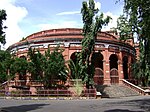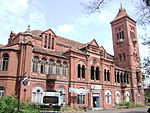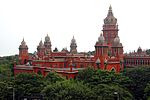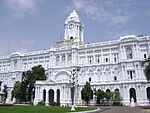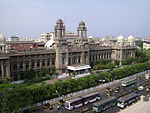 |
| Vijayalaya Choleeswaram, Narthamalai, Pudukkottai District Rebuilt by Vijayalaya Chola |
 |
| Muvar Koil, Pudukkottai District, Paranthaka II |
EARLY CHOLA PERIOD
Aditya Chola
- Thirupparaithurai Tharugavaneswarar, Trichy – Aditya Chola
- Kumaravayalur Tirukattrali Parameswarar, Trichy – Aditya Chola
- Thiruvidaimaruthur Mahalingar, Kumbakonam – Aditya Chola
- Nemam Airavateswarar, Thanjavur – Aditya Chola
- Thillaisthanam Neyyadiappar, Thanjavur – Aditya Chola
- Thiruchottruthurai Othavaneswarar, Thanjavur – Aditya Chola
- Thirupponthuruthi Pasbavaneswarar, Thanjavur – Aditya Chola
- Thiruvedikudi Vedapureeswarar, Thanjavur – Aditya Chola
- Thirupazhanam Abathsahayeeswarar, Thanjavur – Aditya Chola
- Kudanthai Nageeswarar, Kumbakonam – Aditya Chola
- Thiruvayaru Panchnadeeswarar, Thiruvaiyaru – Aditya Chola
- Thirukattalai Sundreeshwarar, Pudukottai – Aditya Chola
- Thirukattupalli Agneeshwarar, Thiruvaiyaru – Aditya Chola
- Keelayur Thenvayil Sreekoil, Nagapattinam – Aditya Chola
- Lalgudi Sapthareeshwarar, Lalgudi, Trichy – Aditya Chola
- Thirupurambiyam Satchinathar, Kumbakonam – Aditya Chola
- Thiruerumbiyur Erumbeeswarar, Thiruverumbur, Trichy – Aditya Chola
- Thiruchendurai Chandrasekarar, Trichy – Aditya Chola
- The Ranganatha Temple at Srirangapatnam, Mandya district, Karnataka - Aditya Chola I
- Nageswaran Temple, Kumbakonam - Aditya Chola I
- Thirukadambatturai Udaiya Mahadevar (Matsyapurisvarar temple), Tudaiyar, Trichy - Aditya Chola I
Paranthaka Chola I
- Uyyakondan Thirumalai Ujjivaneeswarar, Trichy - Paranthaga Chola I
- Nangavaram Sundareeswarar, Trichy - Paranthaga Chola I
- Andanallur Thiru Alanthurai Mahadevar or Vada Tirthanathar, Trichy - Paranthaga Chola I
- Sithalingamadam Viyakrabatheeswarar, Villupuram - Paranthaga Chola I
- Thiruvettriyur Adheepureeswarar, Chennai - Paranthaga Chola I
- Madhuranthagam Sivan and Visnu koil, Kanchipuram - Paranthaga Chola I
- Thiruvamathur Abirameswarar or Nandieswarar, Villupuram - Paranthaga Chola I
- Kattumannarkudi Viranarayana Vinnagar, Chidambaram - Paranthaga Chola I
- Erumbur Kadamabavaneeswarar, Cuddalore - Paranthaga Chola I
- Cholapuram Sivan Koil, Perambalur - Paranthaga Chola I
- Pullamangai Brahmapurirswarar,Papanasam, Thanjavur - Paranthaga Chola I
- Thiruchennampoondi Sadayari, Thanjavur - Paranthaga Chola I
- Thirunamanallur Tiruthondeeswarar, Tiruvannamalai - Paranthaga Chola I
- Thiruvaduthurai Komuktheswarar, Nagapattinam - Paranthaga Chola I
- Alambakkam Kailasanathar, Trichy - Paranthaga Chola I
- Thirukandiyur Virattaneswarar, Thanjavur - Paranthaga Chola I
- Thirupalthurai Adimuleswarar, Trichy - Paranthaga Chola I
- Srinivasanallur Koranganathar, Musiri, Trichy - Paranthaga Chola I
- Valikandapuram Valikandeswarar, Veppanthattai, Perambalur - Paranthaga Chola I
- Thiruvalanchuzhi Temple, Tanjore District, Near Kumbakonam - Paranthaga Chola I
- Tirumalpur, Vellore – Paranthaga Chola I
Sundara Chola / Uthama Chola
- Ponsei Nalthunaieswarar, Mayiladuthurai - Sundra Chola / Uthama Chola
- Perungudi Agastheeswarar, Trichy - Sundra Chola / Uthama Chola
- Konerirajapuram UmaMaheswarar, Mayiladuthurai - Sundra Chola / Uthama Chola
- Thirukodikaval Sivan Koil, Mayiladuthurai - Sundra Chola / Uthama Chola
- Karunthittaikudi Vasisteshwarar, Thanjavur - Sundra Chola / Uthama Chola
- Anangur Sivan Koil, Namakkal - Sundra Chola / Uthama Chola
- Thirunaraiyur Sithanathaswamy,Kumbakonam - Sundra Chola / Uthama Chola
- Courtallam Soleeswarar, Kanchipuram - Sundra Chola / Uthama Chola
- Koviladi Divyaganeeswarar, Trichy - Sundra Chola / Uthama Chola
- Thodaiyur Bishamanganeeswarar,Pudukottai - Sundra Chola / Uthama Chola
- Thirunageswararm Nageswarar, Kumbakonam - Sundra Chola / Uthama Chola
- Sembianmadevi Kailasanathar, Thiruvarur - Sundra Chola / Uthama Chola
- Thirukarugavur Sivan Koil, Thanjavur - Sundra Chola / Uthama Chola
- Govindaputhur Gangasadatharar, Ariyalur - Sundra Chola / Uthama Chola
- Kilapazhuvur Alandurayar, Ariyalur - Sundra Chola / Uthama Chola
- Kodumbalur Thaligal, Pudukottai - Sundra Chola / Uthama Chola
MEDIEVAL CHOLA PERIOD
Rajaraja Chola I
- The Brihadisvara Temple at Thanjavur - Rajaraja Chola I
- Masilamaneeswarar temple, Utatur(Urrattur), Padalur, Trichy - Rajaraja Chola I
- Parameeswarar temple, Thirumangalam, Lalgudi, Trichy - Rajaraja Chola I
- Kuganathaswamy Temple, Kanyakumari – Rajaraja Chola I
- Melpadi Samathi Koil, Vellore – Rajara Chola I
- Narasimmaswamy, Ennairam, Villupuram – Rajaraja Chola I
- Kamarasavalli, Ariyalur – Rajaraja Chola I
- Adhi Lakshmi temple, Natham, Lalgudi, Trichy - Rajaraja Chola I and Kulothunga III
- Virinjipuram, Vellore – Rajaraja I and Kulothunga Chola I
- Tiruvalisvaram temple near Tirunelveli – Rajaraja Chola I / Rajendra Chola I
- Vaidyanatha Temple at Tirumalavadi – Rajaraja Chola I / Rajendra Chola I
- Uttara Kailasa Temple at Thanjavur – Rajaraja Chola I / Rajendra Chola I
Rajendra Chola I
- The Temple of Gangaikondacholisvaram - Rajendra Chola I
- Dharasuram,, Thanjavur – Rajendra Chola I
- Bala Subramaniyar Koil, Theni – Rajendra Chola I
- Ramanatheeswarar koil, Esalam, Villupuram – Rajendra Chola I
LATER CHOLA PERIODRajaraja Chola II
- The Airavatesvara(Raja Rajeswaram) Temple at Darasuram, Kumbakonam - Rajaraja Chola II
- Apradeeswara Temple- Nagar, Lalgudi - Rajaraja Chola II
- Karakoil at Melakkadambur - Kulothunga Chola I
- Amirthakateshwarar Temple, Melakadambur, Chidambaram - Kulothunga Chola I
- Kambhareeswarar Temple, Thirubuvanam, Thanjavur District - Kulothunga Chola I
- Tirupuvanam, Thanjavur – Kulothunga Chola I
- Jambukeswarar Temple, Thiruvanaikaval, Trichy - Kocengannan (Kochenga Chola)
- Vekkaliamman Koil, Uraiyur, Trichy - Kochenga Chola
- Agasteeswarar temple, Perungudi, Trichy - Sundara Chola
- Nandhikeswarar, Thuriyur, Trichy - Sundara Chola
- Achaleeswaram temple, Tiruvarur - Sembian Mahadevi, 10 the century
- Tirunallam Temple(Gandaradityam) – Sembian Mahadevi
- Kailasanathaswamy Temple, Sembianmadevi – Sembian Mahadevi
CHOLA TEMPLES REBUILT
- Vijayalaya Choleeswaram, Naaratahamalai, Pudukottai District - Rebuilt by Vijayalaya Chola I
- Thiruvalithayam - Padi, Chennai - Rajaraja Chola III
- Varadharaja Perumal Temple, Kanchipuram - Rajendra Chola II
- Muvar Koil, Pudukottai - Parantaka II
- Kampaharesvara temple at Tribhuvanam near Kumbakonam - Kulothunga Chola III
- Kailasmudaiyar temple, Cholamadevi, Thiruverumbur, Trichy - Virarajendra Chola
- Patteswarar Temple, Perur, Coimbatore – Karikala Perivalanam
- Tirunageeswaram, Tanjavur – Gandaraditya Chola
- Maada Kovil, Uraiyur, Trichy – Sengan Chola
- Tirupachur, Tiruthani, Chennai – Karikalan Chola
- Thiyagarajar Temple, Tiruvarur - Muchukanta Chola
- Sri Pundarikashan Perumal Temple, Thiruvellarai - Sibi Chakravarthy
- Annamalaiyar Temple, Thiruvannamalai - 9th century Chola king
- Erumbeeswarar temple, Thiruverumbur, Trichy - Early Chola kings
- Amaleesvarar Temple, Gopurapatti, Tiruvassi, Trichy - Early Cholas
- Vada Tirthanathar temple, Andavanallur, Trichy - Early Cholas
- Sundareswarar temple, Paluvur, Karur-Trichy road - Early Cholas
- Ekambareswarar Temple, Chidambaram - Rebuilt by Chola kings
- Kasi viswanathar temple, Thirupattur, Siruganur, Trichy - Unknown Chola king
- Muchukondeeswarar, Kodumbalur, Pudukottai – Unknown Chola king
- Kangeeswarar Koil, Kangaya Nallur, Vellore – Unknown Chola king
- Tiruvakarai, Villupuram – Unknown Chola King
- Tiruvamathur, Villupuram – Unknown Chola King
- Thirutanthoneeswarar, Uraiyur, Trichy – Unknown Chola king
- Sri Ranganatha temple at Srirangam- Unknown Chola king according to Legend
- Thayinum Nalla Iswaram - Aaragalur, Perambalur District, Near Arumbavur - Vana Kovaraiyan, A Chola subsidiary
Thursday, July 7, 2011

































